HC3031 Trends in Global Business Environment: Automation Report
VerifiedAdded on 2023/06/13
|9
|2290
|175
Report
AI Summary
This report examines the impact of automation on the global business environment, analyzing Thomas H. Davenport and Julia Kirby's article "Beyond Automation." It discusses the potential for job displacement due to automation and advocates for a shift towards augmentation, where humans and machines collaborate. The report identifies five approaches for humans to adapt to smart machines: advancing cognitive skills, leveraging unique human intelligence, monitoring and adjusting automated systems, specializing in core areas, and innovating new machine capabilities. It highlights the importance of balancing human intelligence with automation, focusing on augmentation rather than complete replacement, and encouraging continuous skill development to ensure humans can work effectively alongside smart machines. The report concludes with recommendations for organizations and governments to promote augmentation, guarantee jobs, and engage in public dialogue about the future of work.

Paraphrase This Document
Need a fresh take? Get an instant paraphrase of this document with our AI Paraphraser
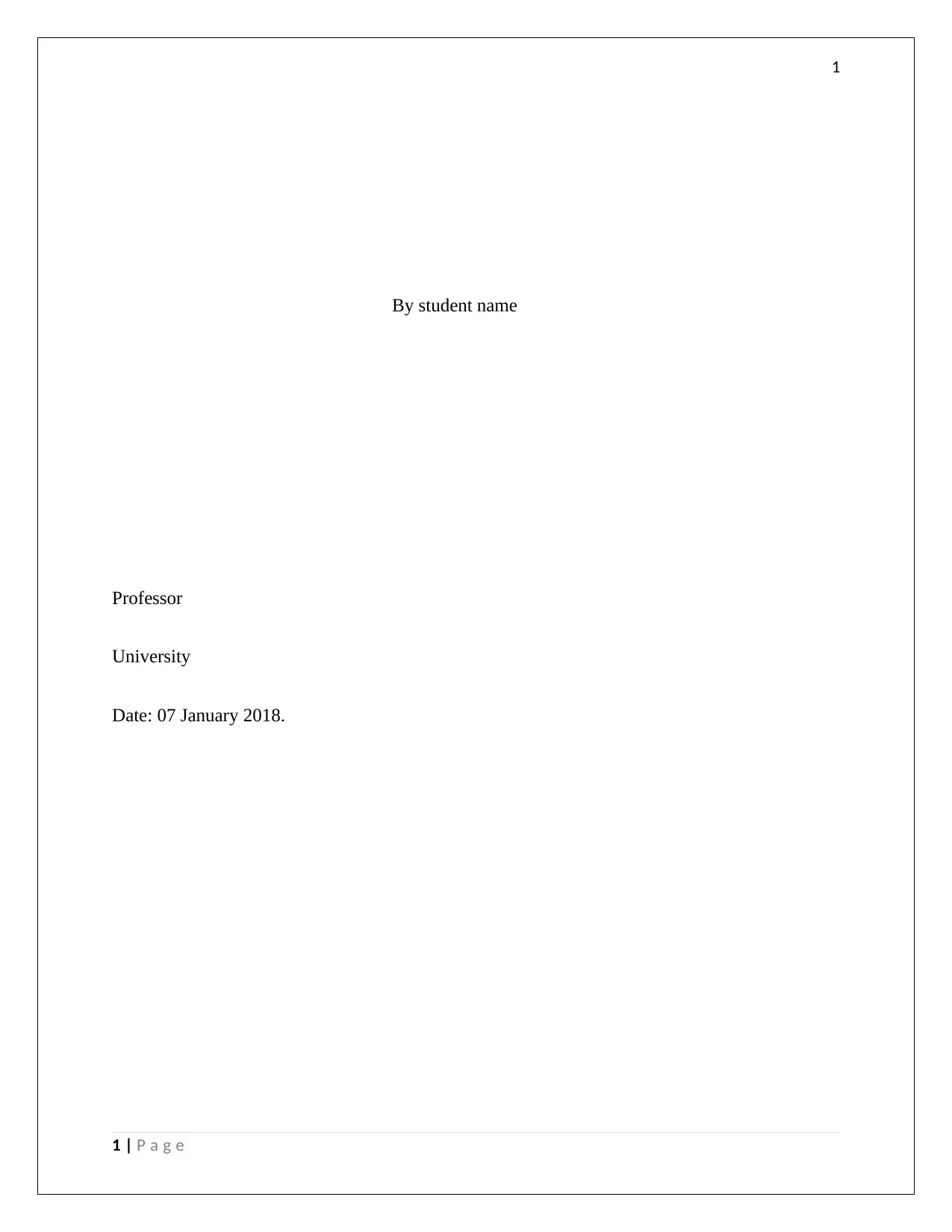
1
By student name
Professor
University
Date: 07 January 2018.
1 | P a g e
By student name
Professor
University
Date: 07 January 2018.
1 | P a g e
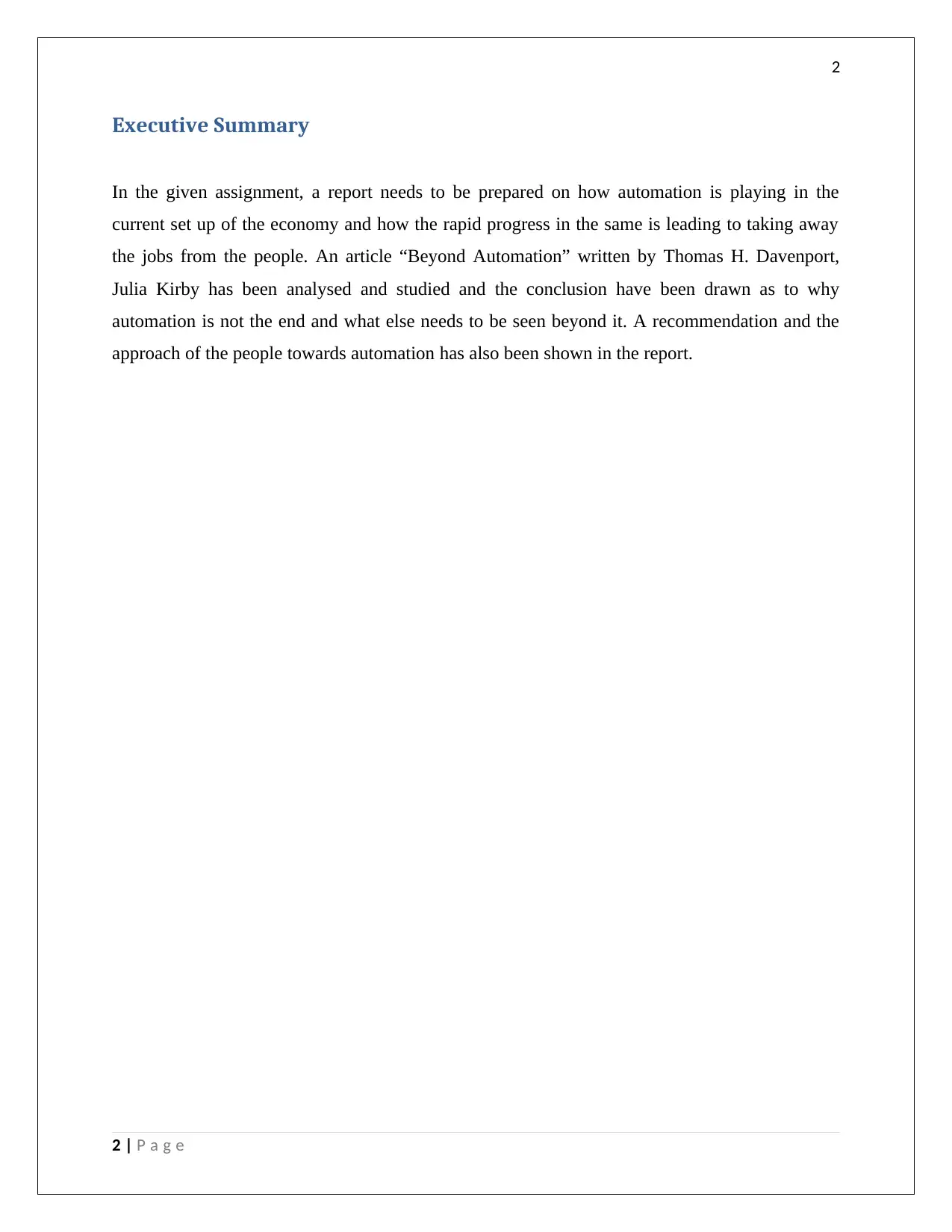
2
Executive Summary
In the given assignment, a report needs to be prepared on how automation is playing in the
current set up of the economy and how the rapid progress in the same is leading to taking away
the jobs from the people. An article “Beyond Automation” written by Thomas H. Davenport,
Julia Kirby has been analysed and studied and the conclusion have been drawn as to why
automation is not the end and what else needs to be seen beyond it. A recommendation and the
approach of the people towards automation has also been shown in the report.
2 | P a g e
Executive Summary
In the given assignment, a report needs to be prepared on how automation is playing in the
current set up of the economy and how the rapid progress in the same is leading to taking away
the jobs from the people. An article “Beyond Automation” written by Thomas H. Davenport,
Julia Kirby has been analysed and studied and the conclusion have been drawn as to why
automation is not the end and what else needs to be seen beyond it. A recommendation and the
approach of the people towards automation has also been shown in the report.
2 | P a g e
⊘ This is a preview!⊘
Do you want full access?
Subscribe today to unlock all pages.

Trusted by 1+ million students worldwide
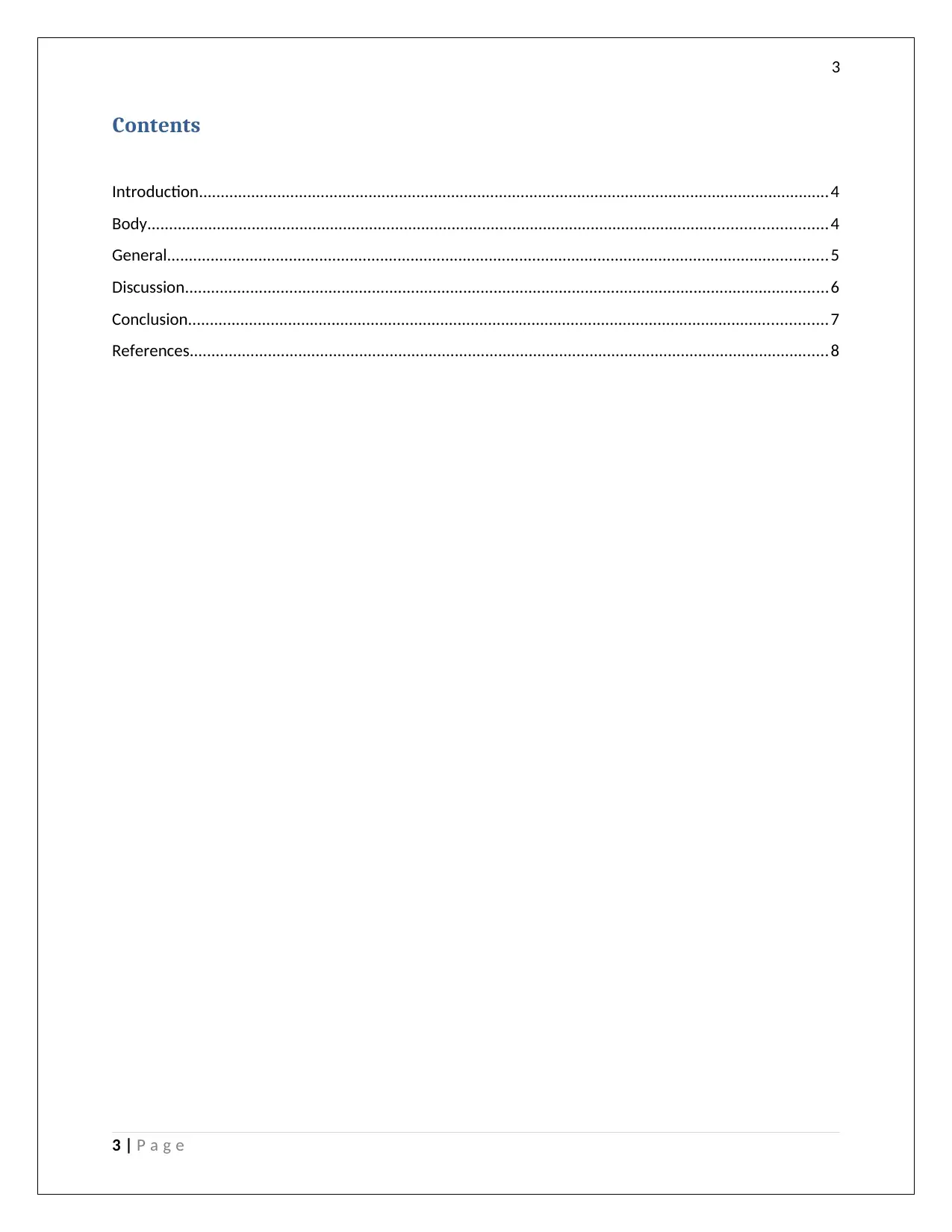
3
Contents
Introduction.................................................................................................................................................4
Body............................................................................................................................................................4
General........................................................................................................................................................5
Discussion....................................................................................................................................................6
Conclusion...................................................................................................................................................7
References...................................................................................................................................................8
3 | P a g e
Contents
Introduction.................................................................................................................................................4
Body............................................................................................................................................................4
General........................................................................................................................................................5
Discussion....................................................................................................................................................6
Conclusion...................................................................................................................................................7
References...................................................................................................................................................8
3 | P a g e
Paraphrase This Document
Need a fresh take? Get an instant paraphrase of this document with our AI Paraphraser
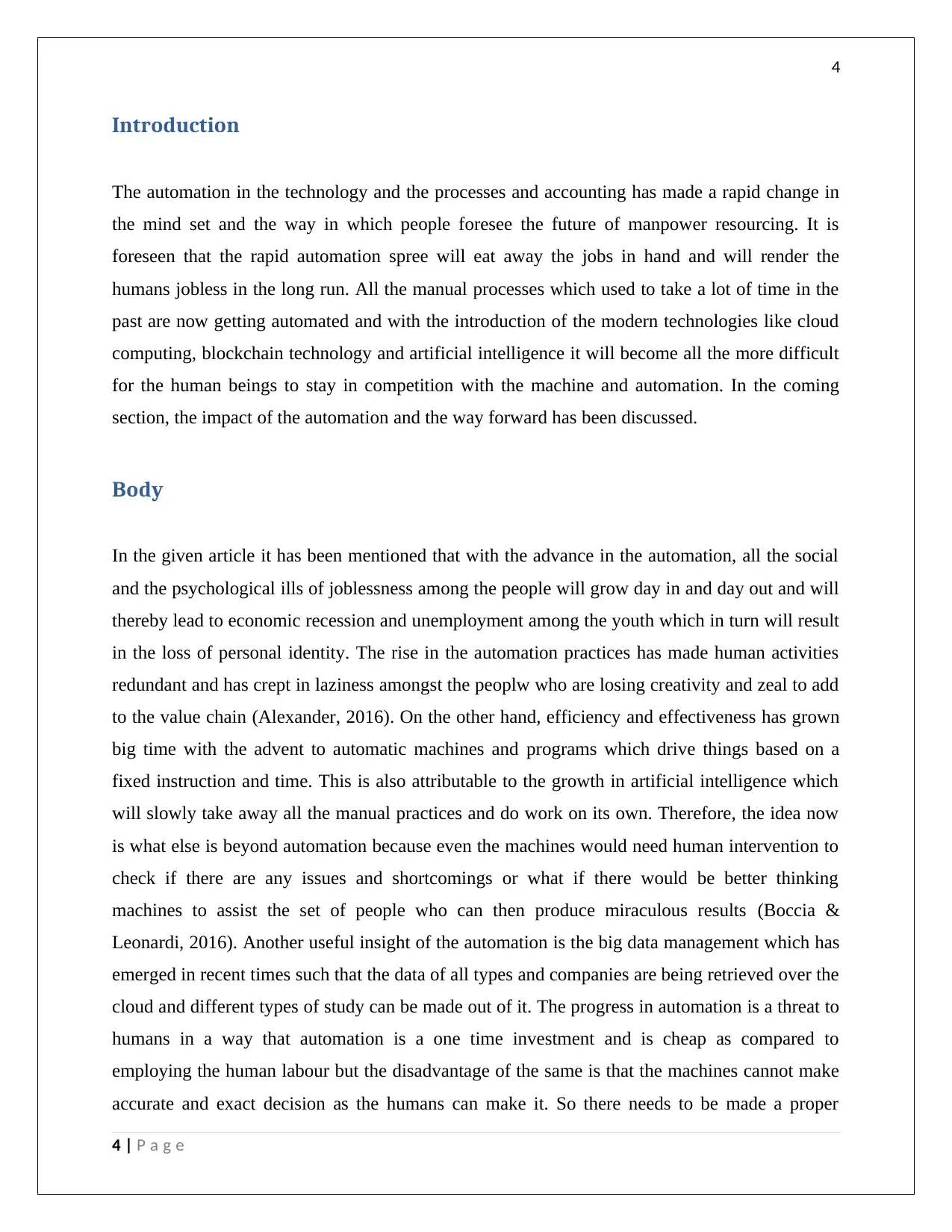
4
Introduction
The automation in the technology and the processes and accounting has made a rapid change in
the mind set and the way in which people foresee the future of manpower resourcing. It is
foreseen that the rapid automation spree will eat away the jobs in hand and will render the
humans jobless in the long run. All the manual processes which used to take a lot of time in the
past are now getting automated and with the introduction of the modern technologies like cloud
computing, blockchain technology and artificial intelligence it will become all the more difficult
for the human beings to stay in competition with the machine and automation. In the coming
section, the impact of the automation and the way forward has been discussed.
Body
In the given article it has been mentioned that with the advance in the automation, all the social
and the psychological ills of joblessness among the people will grow day in and day out and will
thereby lead to economic recession and unemployment among the youth which in turn will result
in the loss of personal identity. The rise in the automation practices has made human activities
redundant and has crept in laziness amongst the peoplw who are losing creativity and zeal to add
to the value chain (Alexander, 2016). On the other hand, efficiency and effectiveness has grown
big time with the advent to automatic machines and programs which drive things based on a
fixed instruction and time. This is also attributable to the growth in artificial intelligence which
will slowly take away all the manual practices and do work on its own. Therefore, the idea now
is what else is beyond automation because even the machines would need human intervention to
check if there are any issues and shortcomings or what if there would be better thinking
machines to assist the set of people who can then produce miraculous results (Boccia &
Leonardi, 2016). Another useful insight of the automation is the big data management which has
emerged in recent times such that the data of all types and companies are being retrieved over the
cloud and different types of study can be made out of it. The progress in automation is a threat to
humans in a way that automation is a one time investment and is cheap as compared to
employing the human labour but the disadvantage of the same is that the machines cannot make
accurate and exact decision as the humans can make it. So there needs to be made a proper
4 | P a g e
Introduction
The automation in the technology and the processes and accounting has made a rapid change in
the mind set and the way in which people foresee the future of manpower resourcing. It is
foreseen that the rapid automation spree will eat away the jobs in hand and will render the
humans jobless in the long run. All the manual processes which used to take a lot of time in the
past are now getting automated and with the introduction of the modern technologies like cloud
computing, blockchain technology and artificial intelligence it will become all the more difficult
for the human beings to stay in competition with the machine and automation. In the coming
section, the impact of the automation and the way forward has been discussed.
Body
In the given article it has been mentioned that with the advance in the automation, all the social
and the psychological ills of joblessness among the people will grow day in and day out and will
thereby lead to economic recession and unemployment among the youth which in turn will result
in the loss of personal identity. The rise in the automation practices has made human activities
redundant and has crept in laziness amongst the peoplw who are losing creativity and zeal to add
to the value chain (Alexander, 2016). On the other hand, efficiency and effectiveness has grown
big time with the advent to automatic machines and programs which drive things based on a
fixed instruction and time. This is also attributable to the growth in artificial intelligence which
will slowly take away all the manual practices and do work on its own. Therefore, the idea now
is what else is beyond automation because even the machines would need human intervention to
check if there are any issues and shortcomings or what if there would be better thinking
machines to assist the set of people who can then produce miraculous results (Boccia &
Leonardi, 2016). Another useful insight of the automation is the big data management which has
emerged in recent times such that the data of all types and companies are being retrieved over the
cloud and different types of study can be made out of it. The progress in automation is a threat to
humans in a way that automation is a one time investment and is cheap as compared to
employing the human labour but the disadvantage of the same is that the machines cannot make
accurate and exact decision as the humans can make it. So there needs to be made a proper
4 | P a g e
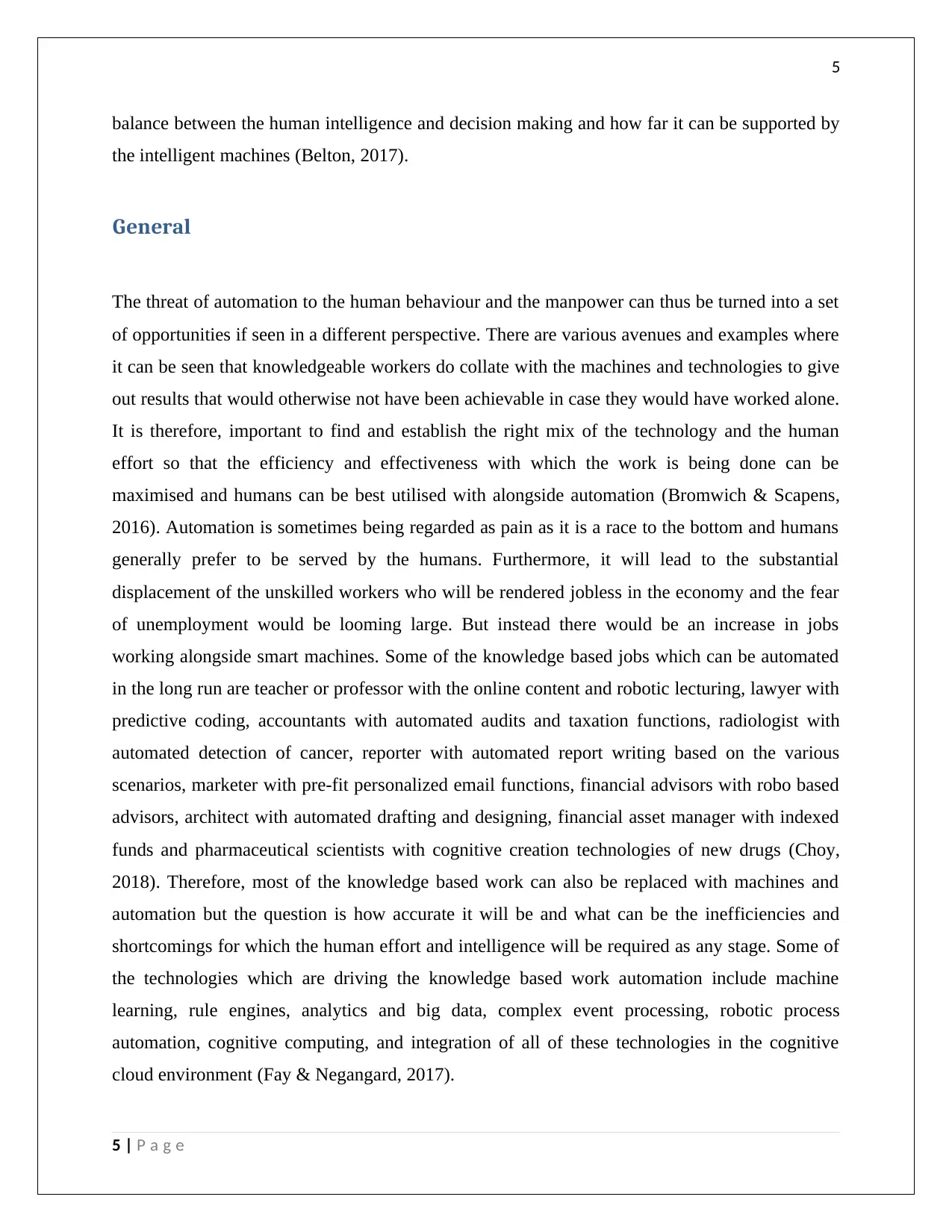
5
balance between the human intelligence and decision making and how far it can be supported by
the intelligent machines (Belton, 2017).
General
The threat of automation to the human behaviour and the manpower can thus be turned into a set
of opportunities if seen in a different perspective. There are various avenues and examples where
it can be seen that knowledgeable workers do collate with the machines and technologies to give
out results that would otherwise not have been achievable in case they would have worked alone.
It is therefore, important to find and establish the right mix of the technology and the human
effort so that the efficiency and effectiveness with which the work is being done can be
maximised and humans can be best utilised with alongside automation (Bromwich & Scapens,
2016). Automation is sometimes being regarded as pain as it is a race to the bottom and humans
generally prefer to be served by the humans. Furthermore, it will lead to the substantial
displacement of the unskilled workers who will be rendered jobless in the economy and the fear
of unemployment would be looming large. But instead there would be an increase in jobs
working alongside smart machines. Some of the knowledge based jobs which can be automated
in the long run are teacher or professor with the online content and robotic lecturing, lawyer with
predictive coding, accountants with automated audits and taxation functions, radiologist with
automated detection of cancer, reporter with automated report writing based on the various
scenarios, marketer with pre-fit personalized email functions, financial advisors with robo based
advisors, architect with automated drafting and designing, financial asset manager with indexed
funds and pharmaceutical scientists with cognitive creation technologies of new drugs (Choy,
2018). Therefore, most of the knowledge based work can also be replaced with machines and
automation but the question is how accurate it will be and what can be the inefficiencies and
shortcomings for which the human effort and intelligence will be required as any stage. Some of
the technologies which are driving the knowledge based work automation include machine
learning, rule engines, analytics and big data, complex event processing, robotic process
automation, cognitive computing, and integration of all of these technologies in the cognitive
cloud environment (Fay & Negangard, 2017).
5 | P a g e
balance between the human intelligence and decision making and how far it can be supported by
the intelligent machines (Belton, 2017).
General
The threat of automation to the human behaviour and the manpower can thus be turned into a set
of opportunities if seen in a different perspective. There are various avenues and examples where
it can be seen that knowledgeable workers do collate with the machines and technologies to give
out results that would otherwise not have been achievable in case they would have worked alone.
It is therefore, important to find and establish the right mix of the technology and the human
effort so that the efficiency and effectiveness with which the work is being done can be
maximised and humans can be best utilised with alongside automation (Bromwich & Scapens,
2016). Automation is sometimes being regarded as pain as it is a race to the bottom and humans
generally prefer to be served by the humans. Furthermore, it will lead to the substantial
displacement of the unskilled workers who will be rendered jobless in the economy and the fear
of unemployment would be looming large. But instead there would be an increase in jobs
working alongside smart machines. Some of the knowledge based jobs which can be automated
in the long run are teacher or professor with the online content and robotic lecturing, lawyer with
predictive coding, accountants with automated audits and taxation functions, radiologist with
automated detection of cancer, reporter with automated report writing based on the various
scenarios, marketer with pre-fit personalized email functions, financial advisors with robo based
advisors, architect with automated drafting and designing, financial asset manager with indexed
funds and pharmaceutical scientists with cognitive creation technologies of new drugs (Choy,
2018). Therefore, most of the knowledge based work can also be replaced with machines and
automation but the question is how accurate it will be and what can be the inefficiencies and
shortcomings for which the human effort and intelligence will be required as any stage. Some of
the technologies which are driving the knowledge based work automation include machine
learning, rule engines, analytics and big data, complex event processing, robotic process
automation, cognitive computing, and integration of all of these technologies in the cognitive
cloud environment (Fay & Negangard, 2017).
5 | P a g e
⊘ This is a preview!⊘
Do you want full access?
Subscribe today to unlock all pages.

Trusted by 1+ million students worldwide
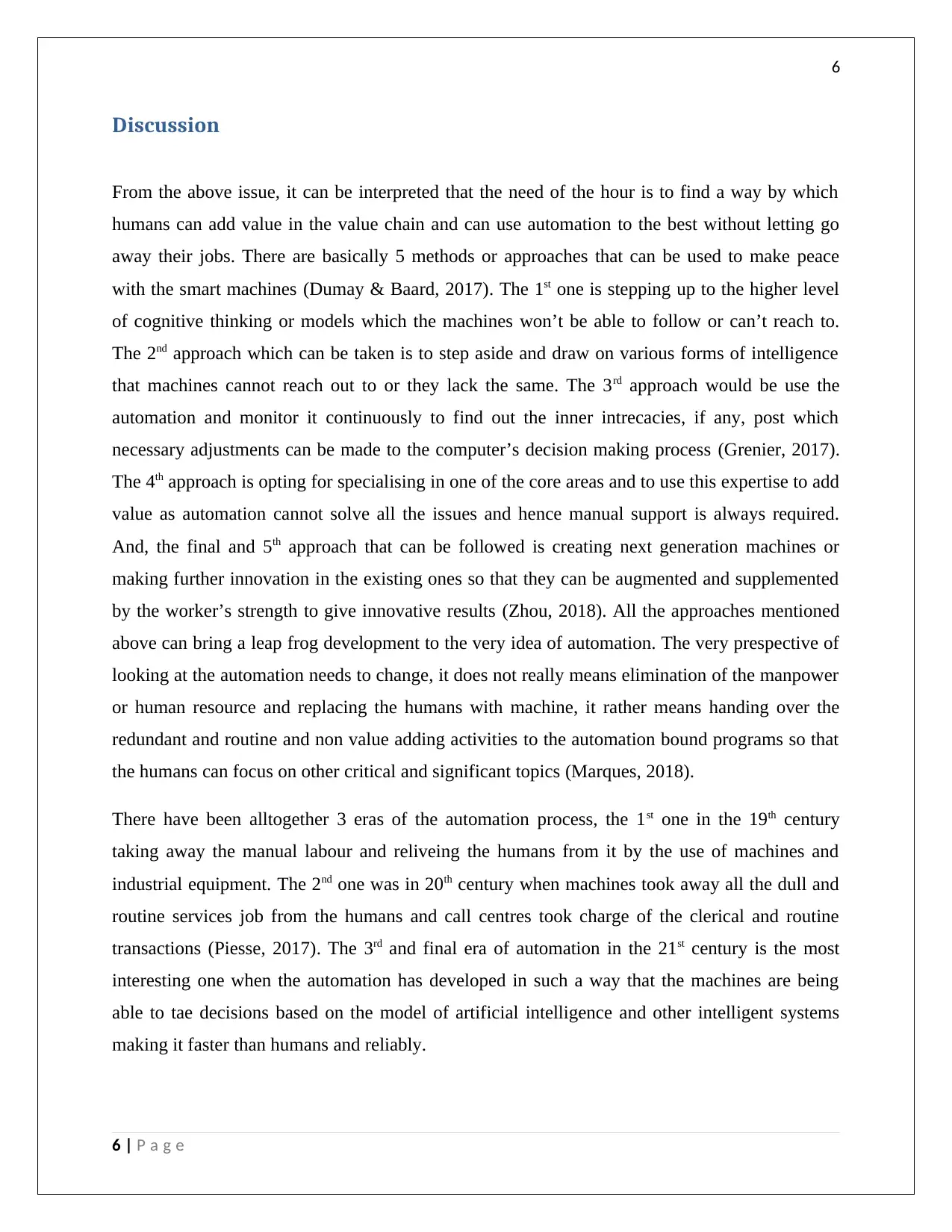
6
Discussion
From the above issue, it can be interpreted that the need of the hour is to find a way by which
humans can add value in the value chain and can use automation to the best without letting go
away their jobs. There are basically 5 methods or approaches that can be used to make peace
with the smart machines (Dumay & Baard, 2017). The 1st one is stepping up to the higher level
of cognitive thinking or models which the machines won’t be able to follow or can’t reach to.
The 2nd approach which can be taken is to step aside and draw on various forms of intelligence
that machines cannot reach out to or they lack the same. The 3rd approach would be use the
automation and monitor it continuously to find out the inner intrecacies, if any, post which
necessary adjustments can be made to the computer’s decision making process (Grenier, 2017).
The 4th approach is opting for specialising in one of the core areas and to use this expertise to add
value as automation cannot solve all the issues and hence manual support is always required.
And, the final and 5th approach that can be followed is creating next generation machines or
making further innovation in the existing ones so that they can be augmented and supplemented
by the worker’s strength to give innovative results (Zhou, 2018). All the approaches mentioned
above can bring a leap frog development to the very idea of automation. The very prespective of
looking at the automation needs to change, it does not really means elimination of the manpower
or human resource and replacing the humans with machine, it rather means handing over the
redundant and routine and non value adding activities to the automation bound programs so that
the humans can focus on other critical and significant topics (Marques, 2018).
There have been alltogether 3 eras of the automation process, the 1st one in the 19th century
taking away the manual labour and reliveing the humans from it by the use of machines and
industrial equipment. The 2nd one was in 20th century when machines took away all the dull and
routine services job from the humans and call centres took charge of the clerical and routine
transactions (Piesse, 2017). The 3rd and final era of automation in the 21st century is the most
interesting one when the automation has developed in such a way that the machines are being
able to tae decisions based on the model of artificial intelligence and other intelligent systems
making it faster than humans and reliably.
6 | P a g e
Discussion
From the above issue, it can be interpreted that the need of the hour is to find a way by which
humans can add value in the value chain and can use automation to the best without letting go
away their jobs. There are basically 5 methods or approaches that can be used to make peace
with the smart machines (Dumay & Baard, 2017). The 1st one is stepping up to the higher level
of cognitive thinking or models which the machines won’t be able to follow or can’t reach to.
The 2nd approach which can be taken is to step aside and draw on various forms of intelligence
that machines cannot reach out to or they lack the same. The 3rd approach would be use the
automation and monitor it continuously to find out the inner intrecacies, if any, post which
necessary adjustments can be made to the computer’s decision making process (Grenier, 2017).
The 4th approach is opting for specialising in one of the core areas and to use this expertise to add
value as automation cannot solve all the issues and hence manual support is always required.
And, the final and 5th approach that can be followed is creating next generation machines or
making further innovation in the existing ones so that they can be augmented and supplemented
by the worker’s strength to give innovative results (Zhou, 2018). All the approaches mentioned
above can bring a leap frog development to the very idea of automation. The very prespective of
looking at the automation needs to change, it does not really means elimination of the manpower
or human resource and replacing the humans with machine, it rather means handing over the
redundant and routine and non value adding activities to the automation bound programs so that
the humans can focus on other critical and significant topics (Marques, 2018).
There have been alltogether 3 eras of the automation process, the 1st one in the 19th century
taking away the manual labour and reliveing the humans from it by the use of machines and
industrial equipment. The 2nd one was in 20th century when machines took away all the dull and
routine services job from the humans and call centres took charge of the clerical and routine
transactions (Piesse, 2017). The 3rd and final era of automation in the 21st century is the most
interesting one when the automation has developed in such a way that the machines are being
able to tae decisions based on the model of artificial intelligence and other intelligent systems
making it faster than humans and reliably.
6 | P a g e
Paraphrase This Document
Need a fresh take? Get an instant paraphrase of this document with our AI Paraphraser
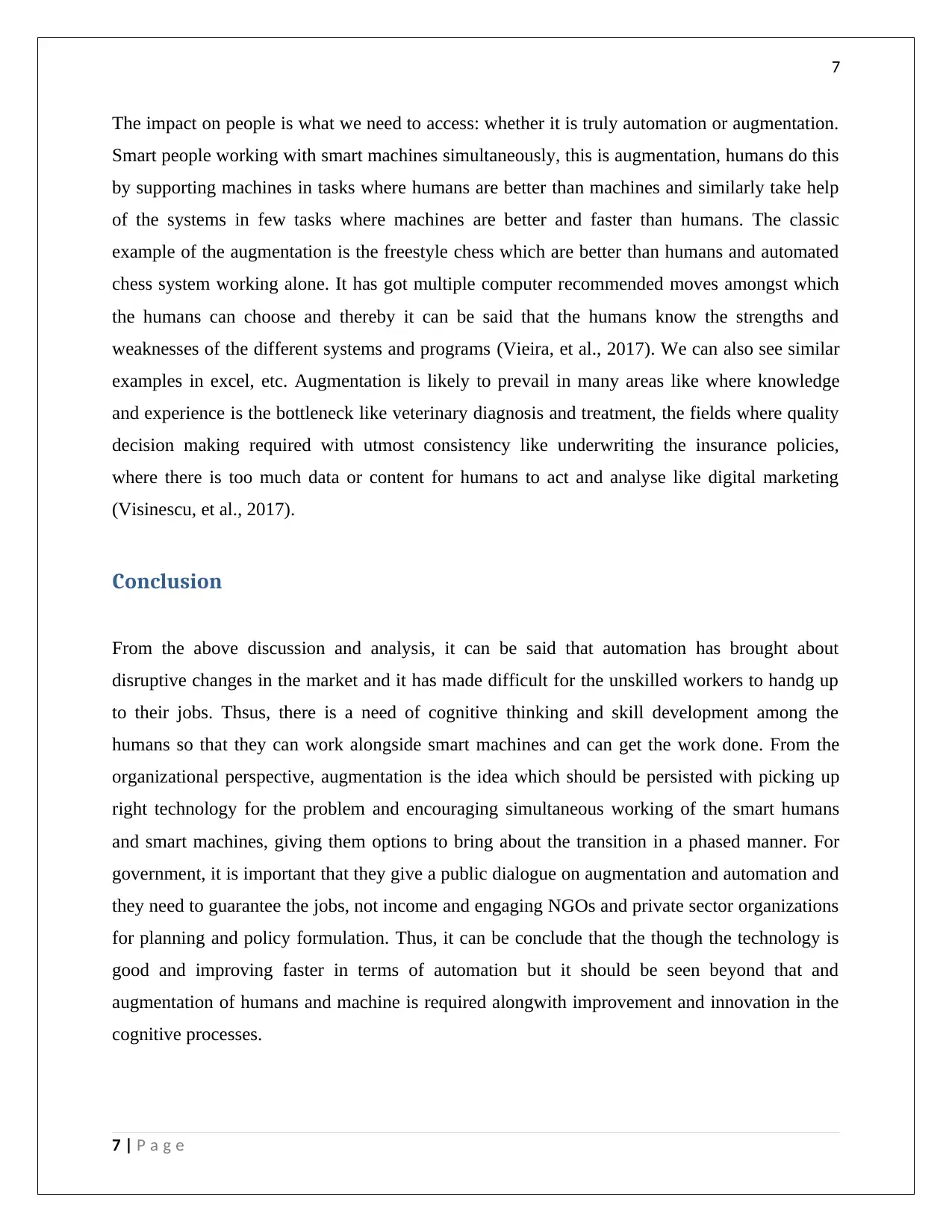
7
The impact on people is what we need to access: whether it is truly automation or augmentation.
Smart people working with smart machines simultaneously, this is augmentation, humans do this
by supporting machines in tasks where humans are better than machines and similarly take help
of the systems in few tasks where machines are better and faster than humans. The classic
example of the augmentation is the freestyle chess which are better than humans and automated
chess system working alone. It has got multiple computer recommended moves amongst which
the humans can choose and thereby it can be said that the humans know the strengths and
weaknesses of the different systems and programs (Vieira, et al., 2017). We can also see similar
examples in excel, etc. Augmentation is likely to prevail in many areas like where knowledge
and experience is the bottleneck like veterinary diagnosis and treatment, the fields where quality
decision making required with utmost consistency like underwriting the insurance policies,
where there is too much data or content for humans to act and analyse like digital marketing
(Visinescu, et al., 2017).
Conclusion
From the above discussion and analysis, it can be said that automation has brought about
disruptive changes in the market and it has made difficult for the unskilled workers to handg up
to their jobs. Thsus, there is a need of cognitive thinking and skill development among the
humans so that they can work alongside smart machines and can get the work done. From the
organizational perspective, augmentation is the idea which should be persisted with picking up
right technology for the problem and encouraging simultaneous working of the smart humans
and smart machines, giving them options to bring about the transition in a phased manner. For
government, it is important that they give a public dialogue on augmentation and automation and
they need to guarantee the jobs, not income and engaging NGOs and private sector organizations
for planning and policy formulation. Thus, it can be conclude that the though the technology is
good and improving faster in terms of automation but it should be seen beyond that and
augmentation of humans and machine is required alongwith improvement and innovation in the
cognitive processes.
7 | P a g e
The impact on people is what we need to access: whether it is truly automation or augmentation.
Smart people working with smart machines simultaneously, this is augmentation, humans do this
by supporting machines in tasks where humans are better than machines and similarly take help
of the systems in few tasks where machines are better and faster than humans. The classic
example of the augmentation is the freestyle chess which are better than humans and automated
chess system working alone. It has got multiple computer recommended moves amongst which
the humans can choose and thereby it can be said that the humans know the strengths and
weaknesses of the different systems and programs (Vieira, et al., 2017). We can also see similar
examples in excel, etc. Augmentation is likely to prevail in many areas like where knowledge
and experience is the bottleneck like veterinary diagnosis and treatment, the fields where quality
decision making required with utmost consistency like underwriting the insurance policies,
where there is too much data or content for humans to act and analyse like digital marketing
(Visinescu, et al., 2017).
Conclusion
From the above discussion and analysis, it can be said that automation has brought about
disruptive changes in the market and it has made difficult for the unskilled workers to handg up
to their jobs. Thsus, there is a need of cognitive thinking and skill development among the
humans so that they can work alongside smart machines and can get the work done. From the
organizational perspective, augmentation is the idea which should be persisted with picking up
right technology for the problem and encouraging simultaneous working of the smart humans
and smart machines, giving them options to bring about the transition in a phased manner. For
government, it is important that they give a public dialogue on augmentation and automation and
they need to guarantee the jobs, not income and engaging NGOs and private sector organizations
for planning and policy formulation. Thus, it can be conclude that the though the technology is
good and improving faster in terms of automation but it should be seen beyond that and
augmentation of humans and machine is required alongwith improvement and innovation in the
cognitive processes.
7 | P a g e
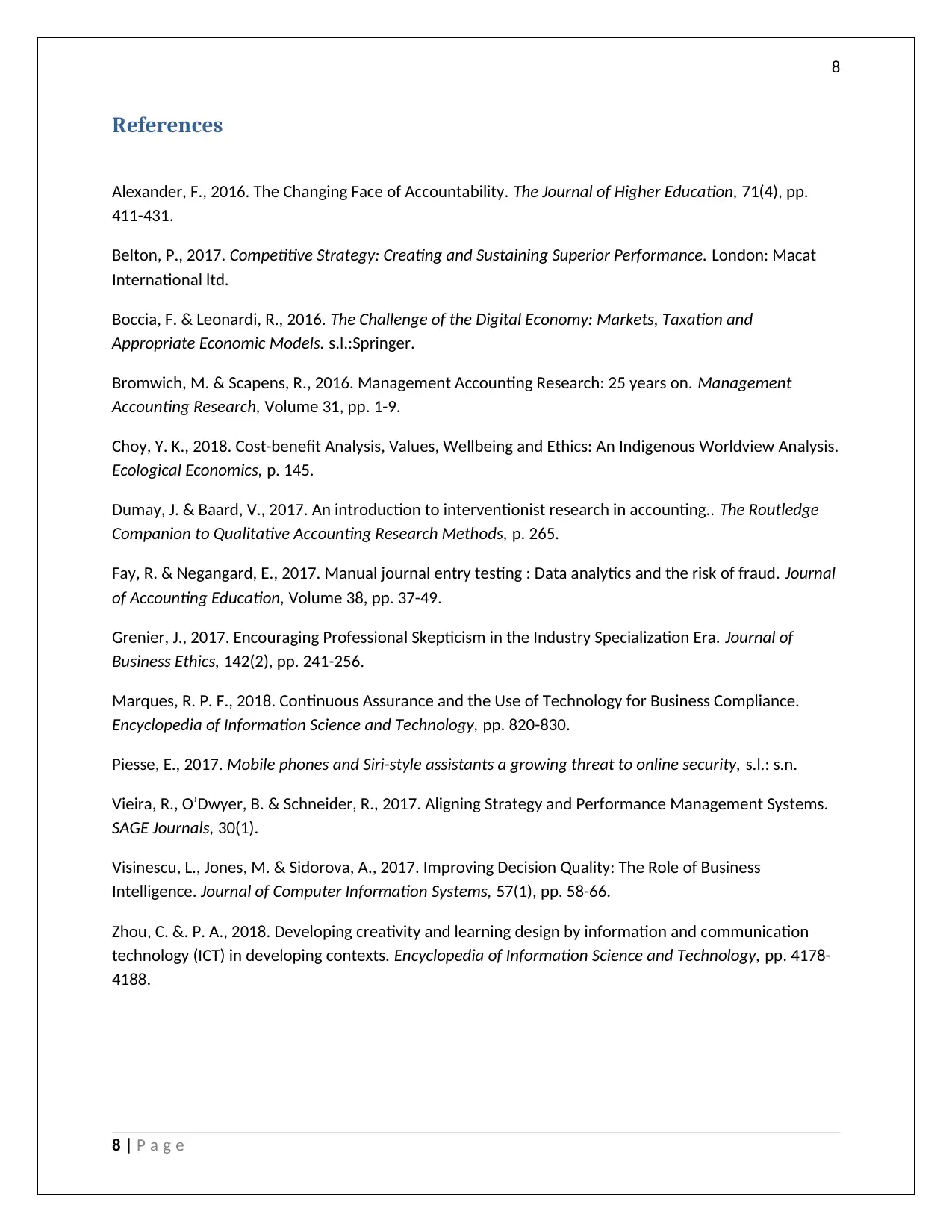
8
References
Alexander, F., 2016. The Changing Face of Accountability. The Journal of Higher Education, 71(4), pp.
411-431.
Belton, P., 2017. Competitive Strategy: Creating and Sustaining Superior Performance. London: Macat
International ltd.
Boccia, F. & Leonardi, R., 2016. The Challenge of the Digital Economy: Markets, Taxation and
Appropriate Economic Models. s.l.:Springer.
Bromwich, M. & Scapens, R., 2016. Management Accounting Research: 25 years on. Management
Accounting Research, Volume 31, pp. 1-9.
Choy, Y. K., 2018. Cost-benefit Analysis, Values, Wellbeing and Ethics: An Indigenous Worldview Analysis.
Ecological Economics, p. 145.
Dumay, J. & Baard, V., 2017. An introduction to interventionist research in accounting.. The Routledge
Companion to Qualitative Accounting Research Methods, p. 265.
Fay, R. & Negangard, E., 2017. Manual journal entry testing : Data analytics and the risk of fraud. Journal
of Accounting Education, Volume 38, pp. 37-49.
Grenier, J., 2017. Encouraging Professional Skepticism in the Industry Specialization Era. Journal of
Business Ethics, 142(2), pp. 241-256.
Marques, R. P. F., 2018. Continuous Assurance and the Use of Technology for Business Compliance.
Encyclopedia of Information Science and Technology, pp. 820-830.
Piesse, E., 2017. Mobile phones and Siri-style assistants a growing threat to online security, s.l.: s.n.
Vieira, R., O’Dwyer, B. & Schneider, R., 2017. Aligning Strategy and Performance Management Systems.
SAGE Journals, 30(1).
Visinescu, L., Jones, M. & Sidorova, A., 2017. Improving Decision Quality: The Role of Business
Intelligence. Journal of Computer Information Systems, 57(1), pp. 58-66.
Zhou, C. &. P. A., 2018. Developing creativity and learning design by information and communication
technology (ICT) in developing contexts. Encyclopedia of Information Science and Technology, pp. 4178-
4188.
8 | P a g e
References
Alexander, F., 2016. The Changing Face of Accountability. The Journal of Higher Education, 71(4), pp.
411-431.
Belton, P., 2017. Competitive Strategy: Creating and Sustaining Superior Performance. London: Macat
International ltd.
Boccia, F. & Leonardi, R., 2016. The Challenge of the Digital Economy: Markets, Taxation and
Appropriate Economic Models. s.l.:Springer.
Bromwich, M. & Scapens, R., 2016. Management Accounting Research: 25 years on. Management
Accounting Research, Volume 31, pp. 1-9.
Choy, Y. K., 2018. Cost-benefit Analysis, Values, Wellbeing and Ethics: An Indigenous Worldview Analysis.
Ecological Economics, p. 145.
Dumay, J. & Baard, V., 2017. An introduction to interventionist research in accounting.. The Routledge
Companion to Qualitative Accounting Research Methods, p. 265.
Fay, R. & Negangard, E., 2017. Manual journal entry testing : Data analytics and the risk of fraud. Journal
of Accounting Education, Volume 38, pp. 37-49.
Grenier, J., 2017. Encouraging Professional Skepticism in the Industry Specialization Era. Journal of
Business Ethics, 142(2), pp. 241-256.
Marques, R. P. F., 2018. Continuous Assurance and the Use of Technology for Business Compliance.
Encyclopedia of Information Science and Technology, pp. 820-830.
Piesse, E., 2017. Mobile phones and Siri-style assistants a growing threat to online security, s.l.: s.n.
Vieira, R., O’Dwyer, B. & Schneider, R., 2017. Aligning Strategy and Performance Management Systems.
SAGE Journals, 30(1).
Visinescu, L., Jones, M. & Sidorova, A., 2017. Improving Decision Quality: The Role of Business
Intelligence. Journal of Computer Information Systems, 57(1), pp. 58-66.
Zhou, C. &. P. A., 2018. Developing creativity and learning design by information and communication
technology (ICT) in developing contexts. Encyclopedia of Information Science and Technology, pp. 4178-
4188.
8 | P a g e
⊘ This is a preview!⊘
Do you want full access?
Subscribe today to unlock all pages.

Trusted by 1+ million students worldwide
1 out of 9
Related Documents
Your All-in-One AI-Powered Toolkit for Academic Success.
+13062052269
info@desklib.com
Available 24*7 on WhatsApp / Email
![[object Object]](/_next/static/media/star-bottom.7253800d.svg)
Unlock your academic potential
Copyright © 2020–2025 A2Z Services. All Rights Reserved. Developed and managed by ZUCOL.



